Heusler compounds for magnetoelectronics and magnetocalorics
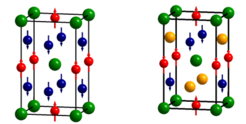
Experiments in high magnetic fields are essential for the understanding of the multi-functional properties found in Heusler alloys. In close cooperation with the Solid State Chemistry Department we investigated the exchange-bias effect in Mn–Pt–Ga Heusler alloys in static and pulsed magnetic fields at the High-Magnetic Field Laboratories in Nijmegen and Dresden (HZDR). Our finding of an exceptionally high exchange-bias in a compensated ferrimagnet may lead to the development of magneto-electronic devices and rare earth-free exchange-biased hard magnets. Pulsed-field experiments, furthermore, permit us to study materials on fast time scales between 10 ms and 1s, which allowed us to probe Ni-Mn-In shape-memory Heusler alloys for the prospective use in magnetocaloric cooling devices. Our results show that the structural and magnetic contributions to the magnetocaloric effect as well as the irreversible behavior observed at the martensitic transition have to be carefully considered for future cooling applications. This work has been carried out in close collaboration with colleagues in the Solid State Chemistry department, ensuring that our findings feed back immediately into material design.
Giant exchange bias in Mn–Pt–Ga Heusler alloys – What can be learned from high-magnetic field studies?
The exchange bias (EB) effect results in a shift of the ferromagnetic magnetization (M) vs. magnetic field (H) hysteresis loop away from the origin along the magnetic field axis. The EB phenomenon originates in the exchange coupling at the interface between a ferromagnet and an antiferromagnet. It is, therefore, usually observed in layered materials and not in bulk samples as we report here. The EB is of high technological relevance, e.g., in the design of new rare-earth free permanent magnets, in the performance of read heads in magnetic storage devices, or in spintronics. Even though future applications will not use magnetic fields in excess of one tesla, in most cases even much smaller fields, pulsed and static high magnetic field experiments are essential for the understanding of the underlying physical principles.
Here, we discuss two closely related findings,
- the design of compensated ferrimagnetic Heusler alloys for a giant tunable exchange bias and
- how a zero-field cooled (ZFC) exchange bias is induced during the virgin magnetization process in bulk Mn2PtGa.
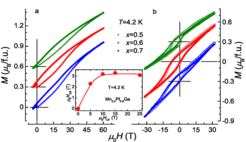

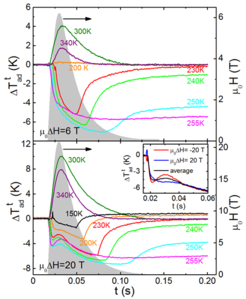
Figure 4: Time dependences of the adiabatic temperature change ∆Ttad(T) at 6 T (top) and 20 T (bottom), measured in pulsed magnetic fields. Each measurement was preceded by heating up the sample to the fully austenitic state and then cooling down to the completely martensitic state (100 K) before approaching the measurement temperature. The field profile is also indicated (right axis). The inset shows ∆Ttad(T) with pulsed fields of 20 T and 20 T at 240 K and the average of the two.
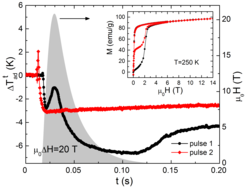
Figure 5: Time dependence of ∆Ttad(T) measured at 250 K for a magnetic-field pulse of 20 T. Before measuring the initial curve (black circles), the sample was heated up to the fully austenite state and then cooled down to the completely martensitic state (100 K). The second curve (red diamonds) was taken 1 h after the first pulse. The field profile is also shown (right axis). The inset shows the corresponding M(H) curves following the same protocol.
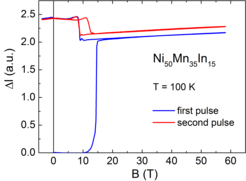
Figure 6: Longitudinal magnetostriction, ∆l/l0, measurements at 100 K for Ni50Mn35In15. The experiments were performed in two steps. In pulse-1 (blue line) the measurements were performed after cooling the sample from room temperature to the measurement temperature. In pulse-2 (red line) the measurement was repeated at the same temperature one hour after the first measurement.





